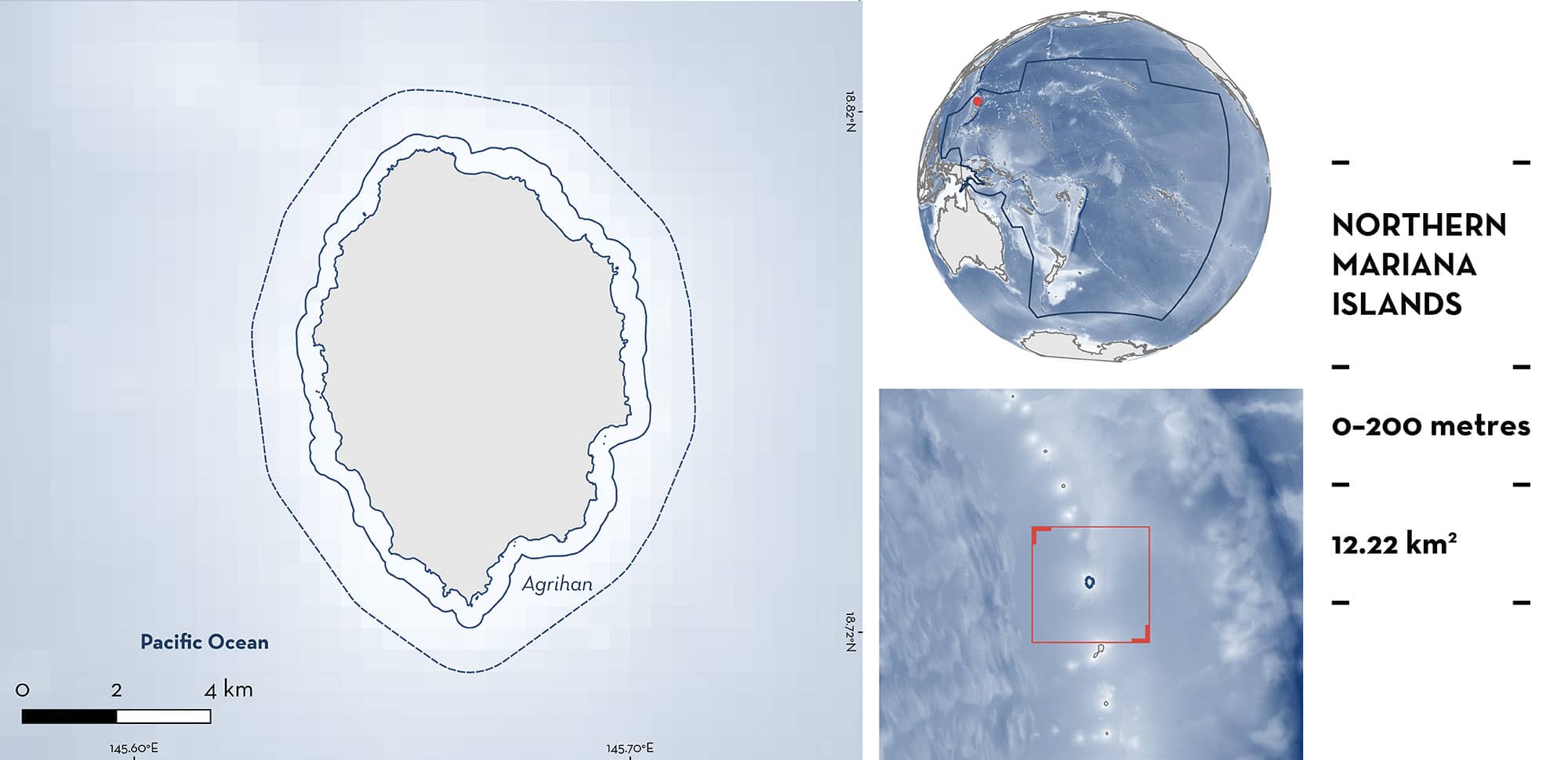ISRA FACTSHEETS
ISRA FACTSHEETS
NEW ZEALAND & PACIFIC ISLANDS REGION
Agrihan
Summary
Agrihan is located in the northern part of the Mariana Arc in the northwest of the Pacific Ocean. It is part of the Commonwealth of the Northern Mariana Islands, a self-governing commonwealth in association with the United States of America. The habitat is mostly coral, with developing reefs that have carbonate deposits but lack a fully formed three-dimensional structure. Within this area there are: threatened species and reproductive areas (Grey Reef Shark Carcharhinus amblyrhynchos).
Download factsheet
Agrihan
DESCRIPTION OF HABITAT
Agrihan is located in the middle part of the Mariana Arc in the northwest of the Pacific Ocean. It is part of the Commonwealth of the Northern Mariana Islands, an unincorporated territory associated with the United States of America (Brainard et al. 2012). This area holds one of the greatest coral assemblage richness of the Northern Mariana Islands (Houk & Starmer 2009). The habitat is mostly coral, with developing reefs that have carbonate deposits but lack a fully formed three-dimensional structure (Brainard et al. 2012). There are also large rocks with a reef matrix made from coral skeletons cemented by coralline algae, and high-relief structures with carbonate foundations that are well-colonised by marine life (Houk & Starmer 2009).
This Important Shark and Ray Area is delineated from surface waters (0 m) to 200 m based on the bathymetry of the area.
CRITERION A
VULNERABILITY
One Qualifying Species considered threatened with extinction according to the IUCN Red List of Threatened Species regularly occurs in the area. This is the Endangered Grey Reef Shark (Simpfendorfer et al. 2020).
CRITERION C
SUB-CRITERION C1 – REPRODUCTIVE AREAS
Agrihan is an important reproductive area for one shark species.
Observations have been made from contemporary and historical towed-diver surveys (TDS) and stationary point count (SPC) surveys. The TDS method involves two divers towed behind a boat (~2.2 km track). The diver at ~15 m depth recorded the number, size (TL), and species of all fishes measuring >50 cm total length (TL) within a belt-transect extending 5 m on either side and 10 m in front of the diver, from the bottom to the surface (total area surveyed = 20,000 km2) (Brainard et al. 2012). The SPC survey involved two divers conducting simultaneous counts of all fishes in adjacent, visually estimated 15-m-diameter cylindrical plots extending from the substrate to the limits of vertical visibility. The SPC survey is a comprehensive small-scale survey approach that covers small areas of the reef (~350–600 m2), thus, aggregations, and rare and patchily distributed species are not well surveyed (Brainard et al. 2012).
Aggregations of up to 34 young-of-the-year (YOY) and juvenile Grey Reef Sharks were recorded in the area. These were determined to be YOY and juveniles based on the size-at-birth of this species (45–60 cm total length [TL]; Ebert et al. 2021) and the size-at-maturity (120–145 cm TL; Ebert et al. 2021).
Between 2009–2017, 31 TDS were conducted in the area (2009 = 11; 2011 = 10; 2017 = 10) (CREP PIFSC 2017a, 2017b). Fourteen aggregations were recorded with group sizes ranging from 3–23 individuals (size range 65–150 cm TL, most <100 cm TL) (CREP PIFSC 2017a, b; ESC PIFSC 2019). In addition, during the expeditions but ‘off transect’, aggregations of four individuals (125 cm TL) and 23 (n = 12 [88 cm TL] + n = 11 [125 cm TL]) were observed in 2003, and one aggregation (n = 9; 90 cm TL) in 2009 (ESC PIFSC 2019).
Download factsheet
SUBMIT A REQUEST
ISRA SPATIAL LAYER REQUEST
To make a request to download the ISRA Layer in either a GIS compatible Shapefile (.shp) or Google Earth compatible Keyhole Markup Language Zipped file (.kmz) please complete the following form. We will review your request and send the download details to you. We will endeavor to send you the requested files as soon as we can. However, please note that this is not an automated process, and before requests are responded to, they undergo internal review and authorization. As such, requests normally take 5–10 working days to process.
Should you have questions about the data or process, please do not hesitate to contact us.


